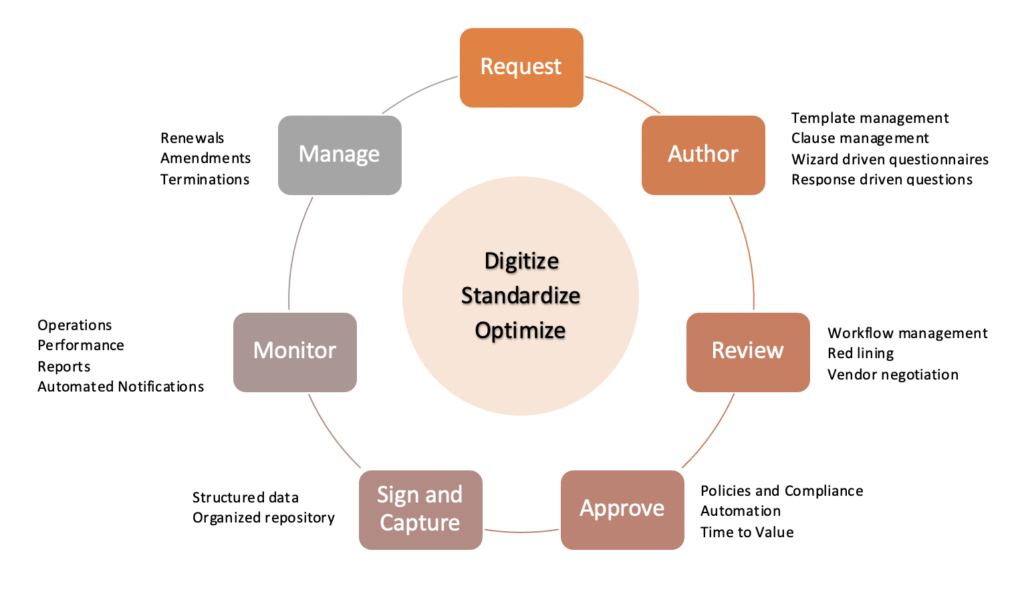A Paradigm Shift in Contract Lifecycle Management (CLM) – Part 1
January 26, 2021
Contract Lifecycle Management is quickly starting to take a front seat in procurement value realization. In recent years, contract lifecycle management (CLM) has advanced beyond authoring, negotiating and signing, into effectively operationalizing contracts. In this 2-part blog series, I will take a closer look at the key principles of advanced CLM.
CLM is a crucial piece in any deal. According to one study, inefficient contract management may result in organizations losing 17 to 40 percent of the contract value from the time the contract is active to its close out.
Carefully structured approval flows must be put in place to ensure the accurate review of contracts. This structure must also take into account which people have the critical knowledge on each contract and when the right time to engage them would be. This reduces the risk of value leakage later on. Think of this as a “pay it forward” mechanism that delivers in dividends in the future.
Conducting organizational interviews can help you drive a precise approval flow. This process reduces clutter for your reviewers and preemptively eliminates contract review fatigue as not everyone has to review every contract. For example, an approval matrix driven by the total contract value ensures the right level of scrutiny is done only when needed on a contract. Similarly, using Data Privacy / GDPR considerations will require review by the compliance team only if Data Privacy needs to be addressed.

Advanced Contract Lifecycle Management
Companies enter into contracts either from a buy side perspective, a sell side perspective, or a combination of both. The complexity of contracts has increased over time and diversity of services has expanded in order for companies to establish and maintain dominance in the marketplace.
As CLM has evolved, there has been continued scrutiny of the performance of contracts and a renewed attention to risk mitigation. There is uncertainty that needs to be addressed when you have a lack of visibility on where the contract is in the lifecycle. You also need to a strong attention to the obligations your company exposes itself to with contract terms by taking a proactive approach to operations of contracts as opposed to reacting to urgencies. It is not just how well a contract is authored but how effectively we can execute its operation.
Many organizations have hundreds or thousands of legacy contracts on paper that are in different stages of the CLM lifecycle. It is essential to bring these contracts into a centralized repository as part of your program implementation and that leads to multiple benefits.
This allows you to capture metadata for these legacy contracts in a structured format that helps report and monitor their performance. The legacy contracts can then be operationalized to meet obligations related to renewals and amendments. Also, you can proactively notify sourcing and contract specialists of amendment and termination processing. Advanced search capabilities can also enable exploration of the content for strategic data like contract terms. This reduces search time to minutes as opposed to days of “stare and compare” analysis.
A major challenge with contract lifecycle is the time it takes for a contract to go live. You cannot realize the benefits or enforce contract compliance unless the contract is operational. Adopting key design principles that drive a standard workflow enables expediency to realizing value for customers. During implementation, define workflows based on meeting compliance to audit or regulatory requirements and limit exposure to risk. This is where the structured data that you defined and captured at the time of authoring (or migrating vendor paper contracts) plays a big role. You can now put your data to work and be more prescriptive with total contract value, contract terms and responses to clause usage in driving additional reviews only if they are needed.
The notifications can be automated and reminders can be set to nudge the workflow forward. The platform is able to capture the redlines during the reviews and negotiations as different versions are easily available in one place for historical reference and edits. In addition, customers benefit from implementing electronic signature workflows available from external services like DocuSign that can be set up to reduce the time and effort involved with ink signatures.
The contract is not a static document once it becomes active. Automating and managing contract operations should focus on ensuring that actions are taken prior to contract renewals via notifications to contract management teams. Centralizing the contracts like MSAs, associated amendments and SOWs in one repository can provide the right kind of knowledge to the contract management teams to effectively deal with renewals. Segmenting and prioritizing high value contracts for detailed reviews with timed notifications and automating the contracts that may not need detailed scrutiny leads to focusing on value where it matters most to the organization’s business outcomes.
To get high performance from contracts and to shorten time-to-value of your contracts, you need to standardize. The guiding principles for standardization for contracts includes contract assembly, templates and clauses and will be our topic for Part 2 of this blog which will be published in January, 2021.
Mo Fakhar – Director, Advanced Platform Practice
